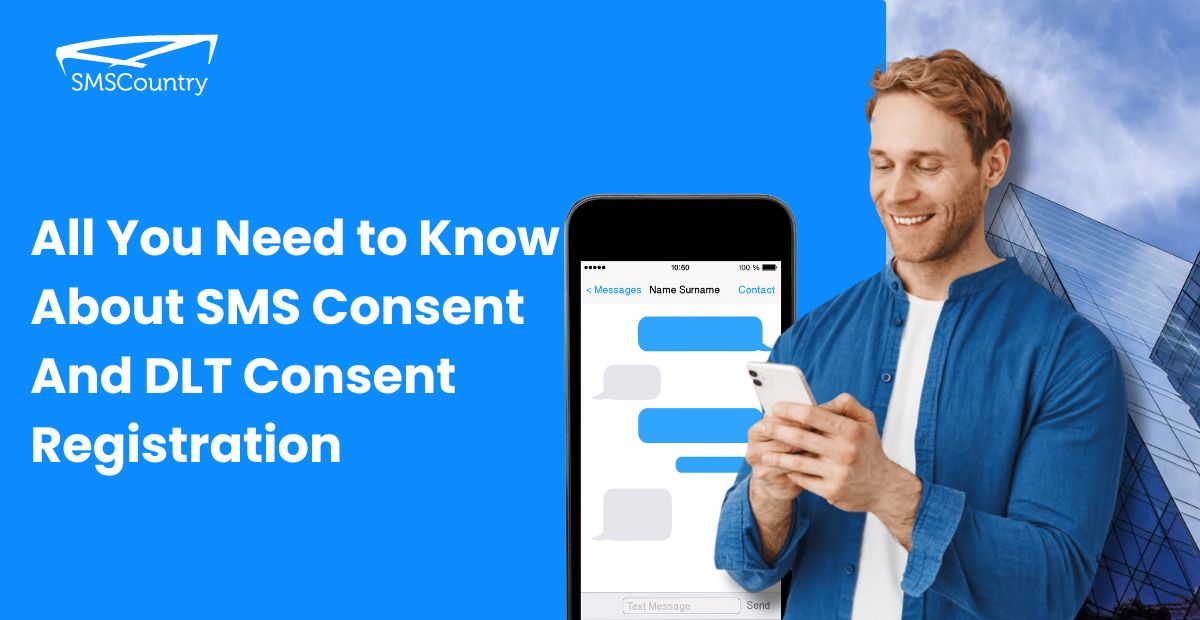This article provides a comprehensive guide to SMS and DLT consent registration for businesses in India. You’ll have everything you need for successful SMS campaigns by the end.
Let’s get started.
| Having issues completing your DLT consent registration? Our team can help you. Contact us or send an email to info@smscountry.com. |
What is SMS consent?

SMS consent is permission given by a customer or prospect to receive SMS messages from a business or marketer. It is a legal requirement of the Telecom Regulatory Authority of India (TRAI).
SMS consent shows respect for customers’ privacy and preferences.
What are the different types of SMS consent?
There are two types of SMS consent: express and implied consent.
#1. Express SMS consent
This is when a customer or prospect explicitly agrees to receive SMS messages from a business or marketer.
How do you obtain express consent?
You can get express content through various channels like
- Online forms
- Opt-in boxes
- SMS keywords, or
- Verbal agreements.
An express consent request should include the message’s purpose, frequency, and easy opt-out.
Examples of express SMS consent
Example #1: A customer fills out your online form and agrees to receive SMS messages about your products and services. They can opt out at any time by replying STOP.
“I agree to receive SMS messages from {#your business#} about your products and services. I can opt out at any time by replying STOP.”
Example #2: A prospect texts a keyword to a short code to join your royalty program. And receives a confirmation message that says
“Thank you for joining our loyalty program. You will receive SMS messages from us with exclusive offers and discounts. To opt out, reply STOP.”
Example #3. A customer calls a business to make a reservation. Then the agent asks them
“Would you like to receive SMS messages from us with reminders and confirmations of your reservation? You can opt-out at any time by replying STOP.”
The customer replies, “Yes, please.”
#2. Implied SMS consent
Implied consent is based on their existing relationship or behaviour. It occurs when the customer or prospect
- Gives their phone number to the business or marketer,
- Makes a purchase or inquiry, has participated in a contest or survey, or
- Hasn’t yet opted out after receiving an initial SMS message.

Examples of implied SMS consent
Example #1. A customer buys a product from a business online and provides their phone number during checkout. You then send them an SMS message that says
“Thank you for your purchase. Your order number is #123456. You will receive SMS updates on the status of your delivery. To opt-out, reply STOP.”
Example #2 A prospect visits your website and downloads an ebook (or a whitepaper). You then send them this SMS message
“Thank you for downloading our ebook. We hope you find it useful. You may also be interested in our other resources and services. To opt-out, reply STOP.”
Example #3 A customer participates in a contest or a survey of a business and provides their phone number as part of the entry or feedback form. You send them an SMS message that says
“Thanks for joining our contest/survey! Win a prize in our draw. Receive news & offers related to your interests. To opt-out, reply STOP.”
Learn more about DLT:
- What is an SMS Content Template? All You Need to Know
- Complete guide to DLT registration in India
- 4 expert tips for a successful DLT registration
- 5 Reasons for DLT Registration Rejection and How To Avoid Them
- 4 Top Reasons Your DLT Template Registration will be Rejected
What are the consent requirements for different types of messages?
The Telecom Regulatory Authority of India provides simple and easy guidelines to follow if you must send SMS messages in India.
There are three main categories of SMS messages: 2-way, transactional, and promotional.
Let’s take a closer look at their respective guidelines.
2-way SMS

Two-way SMS allows you to send and receive text messages on your mobile phone number. It is not the same as transactional and promotional SMS.
To send two-way SMS in India, you must
- Become a registered sender as Principal Entity business/legal/govt.
- Register your header using an alphanumeric string of not more than 11 characters. Example: “VD-KOTAKB” and “JD-IPAYTM” only.
- Register Content Template. This may have fixed and variable parts per the code of practice.
- Register your customer’s consent through a registered consent template.
Here’s an example of a suitable two-way SMS.
Sender: MYBANKCO
Message: Hi Ednar, your recent transaction of $100 was successful. For inquiries, reply to this SMS or call our helpline. Thank you!
The message content is concise, informative, and within the SMS character limit.
Transactional SMS
Transactional SMS provides critical information or facilitates actions without promoting sales. These messages are not promotional.
Here are TRAI guidelines for transactional SMS:
- Implied consent is a must-have.
- No need for an opt-out option.
- No time restrictions.
- DND numbers aren’t restricted.
- Sender IDs are a must, which must include a six-character ID that represents your brand name.
Here’s an example of a compliant 2-way transactional SMS.

The example includes a six-character sender ID, “BRNDID”, representing the brand name. The message has 126 characters, well within the 160-character limit for an SMS.
Promotional SMS
Promotional SMSes promote products, services, or businesses. They include coupons, discounts, surveys, contests, or newsletters.
Promotional SMS has stricter consent requirements.
- Time restrictions: Send between 9 AM to 9 PM, Monday to Sunday.
- DND numbers: Excluded from promotional messages.
- Sender ID required: 6-digit with an auto prefix (the client decides on other digits).
- Get express written consent from your customers.
- Clearly state the purpose and frequency of your messages. Also include your terms and conditions, privacy policy, and message and data rates.
- Provide an easy-opt-out process.
Here’s a compliant SMS example for a promotional message.

The example includes a six-digit sender ID “TXTSALE” and a promotional message that complies with the requirements.
The message has 158 characters, within the 160-character limit for an SMS.
| Having issues completing your DLT consent registration? Our team can help you. Contact us or send an email to info@smscountry.com. |
What counts as SMS consent?
SMS consent varies based on location, message type, purpose, and consent collection method.
What are the legal requirements for obtaining SMS consent?
The TRAI guidelines apply to all businesses sending SMS messages to Indian customers.
These guidelines aim to protect customers from unwanted commercial communications. You must register consent templates on the DLT platform before sending promotional SMS messages.
You must get express written consent from customers before sending promotional SMS messages.
How can I obtain consent from recipients before sending SMS messages?
There are different ways to get consent from your recipients. They all depend on the type and purpose of your SMS messages. Here are some standard methods:
#1. Online forms

You can use online forms on your website, landing page, or social media to collect phone numbers and consent from your visitors.
Clearly state that by providing their phone number, they agree to receive your SMS messages. Also include a link to your terms and conditions, privacy policy, and message and data rates.
Checkboxes or buttons can make the opt-in process easy and visible.
#2. SMS keywords
You can use SMS keywords to allow your recipients to opt-in to your SMS messages by texting a specific word or phrase to a short or long code.
For example, “Text OFFER to 12345 to receive exclusive deals and discounts”.

Send a confirmation message to your recipients after they opt in. State the purpose and frequency of your messages and an easy opt-out mechanism.
#3. Verbal agreements
You can use verbal agreements to obtain consent from your recipients over the phone or in person.
Here’s a verbal agreement between a sales agent and a prospect named Mr Kabir.
Sales agent: “We value your interest in our services. Before we conclude, may I kindly request your verbal consent to send you SMS updates about our latest product launches and exclusive offers?”
Mr Kabir: “Of course! I’d love to stay updated. Please send me the SMS updates.”
Next, record the verbal agreement. Then send a confirmation message to your recipients after they opt in. The message should state the purpose and frequency of your messages. It must also include an easy opt-out mechanism.
What is a consent template?
A consent template is a standard message sent to your recipients to get their agreement to receive your SMS messages. A consent template is required only for promotional SMS messages.
A consent template should include the following information:
- The name and identity of your business or organisation
- The type and purpose of the SMS messages you will send
- The frequency or number of SMS messages you will send
- The message and data rates that may apply
- The terms and conditions and privacy policy of your SMS service
- The opt-out mechanism for your recipients
Here’s how it looks like
[Your Business Name]: We’d like to send you exciting updates! Reply YES to receive promotional SMS. Msg freq may vary. Std rates apply. T&Cs: [Your Website URL]. To stop, reply STOP.
What is the role of DLT in obtaining and managing SMS consent?
DLT plays a vital role in obtaining and managing SMS consent.
It ensures that:
- Your recipients give their express written consent to receive SMS messages from you
- Your consent templates are clear, concise, and compliant with the regulations
- Your recipients can easily opt out of your SMS messages at any time
- Your SMS messages are verified and validated by the DLT platform
- Your SMS service provider is registered and authorised by the DLT platform
What are consent template format guidelines?
Consent template format guidelines may vary based on different factors. Like, the country or region you operate in, type and purpose of messages, and consent collection method.
However, here are some general guidelines:
- Use clear, concise, and simple language that is easy to understand by your recipients.
- Include the name and identity of your business or organisation.
- Include the type and purpose of the SMS messages you will send.
- Include the frequency or number of SMS messages you will send.
- Include the message and data rates that may apply.
- Include the terms and conditions and privacy policy of your SMS service.
- Include the opt-out mechanism for your recipients.
- Follow the specific format and character limit required by your telecom operator.
Step-by-step process to register consent templates on the DLT platform
The consent registration process is usually part of the DLT registration process for the telecom operator you use.
Check out our comprehensive guide on DLT registration for:
- Airtel DLT Registration Process
- BSNL DLT Registration Process
- Vodafone DLT Registration Process
- Jio DLT Registration Process
- MTNL DLT Registration Process
- Videocon (PingConnect) DLT Registration Process
Why do consent templates get rejected?
There are various reasons why the telecom operator or the DLT platform may reject your consent template. Here are some of the common reasons why.
- Consent template doesn’t match the type and purpose of your SMS messages: For example, if you send promotional SMS messages, you should not use an implicit consent template.
- Your consent template does not include the required information: Such as the name and identity of your business or organisation, the frequency or number of SMS messages you will send, the message and data rates that may apply, the terms and conditions and privacy policy of your SMS service, and the opt-out mechanism for your recipients.
- Your consent template contains invalid or incorrect variables or text: For example, you should use {#var#} to identify the variable parameters in your consent template.
- Your consent template is not clear, concise, nor easy to understand: It contains jargon, abbreviations, or misleading statements in your consent template.
What to do instead? Follow these best practices.
Best practices for obtaining SMS consent

Here are some best practices for SMS consent:
- Choose the appropriate type of SMS consent.
- Use clear and transparent opt-in mechanisms. Also include a link to your terms and conditions, privacy policy, and message and data rates in your opt-in form or message.
- Provide value and relevance for your SMS messages. Only send SMS messages that are useful, timely, and personalised for your customers or prospects.
- Respect customers’ preferences and interests by segmenting your audience accordingly.
- Respect the time limits for SMS messages. Only send SMS messages during reasonable hours.
- Avoid sending too many messages. They will annoy and overwhelm your customers or prospects.
- Provide easy and conspicuous opt-out instructions. You should always offer an easy way for your customers or prospects to opt out of your SMS messages if they wish. Also, honour their opt-out requests promptly and remove them from your subscriber list.
Why is compliance with SMS and DLT consent regulations important?
Compliance with SMS and DLT consent regulations is essential for several reasons:
- It protects the privacy and rights of your customers or prospects.
- It protects your business from legal risks and penalties like fines, lawsuits, or damage to reputation.
- It enhances your brand image and customer loyalty. It helps you communicate with your customers or prospects ethically, .
Now that’s everything you need to know about SMS consent and consent registration on DLT.
How can you ensure faster DLT registration and compliance? That’s our sweet spot.
SMSCountry simplifies the tedious process by helping you with your DLT registration.
Contact us today, and let’s get to work.
Frequently Asked Questions (FAQs)
Can I send promotional SMS without consent?
No, you can’t send promotional SMS without consent from your recipients. Consent is a legal requirement for SMS marketing and a sign of respect and trust. Sending SMS without consent can result in fines, lawsuits, or reputational damage. It can also hurt your customer loyalty and engagement.
Does SMS consent expire?
No, SMS consent does not expire unless your recipients opt out of your SMS messages or revoke their consent. However, it is a good practice to refresh your consent database periodically and remove any inactive or invalid numbers. You should also monitor your opt-out rate and feedback from your recipients to ensure that your SMS messages are still relevant and valuable.
Is SMS opt-in legal?
Yes, SMS opt-in is legal and mandatory for SMS marketing. SMS opt-in is a recipient’s action to show that they have permitted you to text them for marketing purposes. SMS opt-in can be done through various channels, such as online forms, opt-in boxes, SMS keywords, or verbal agreements.
What is an example of text consent?
Text consent is the permission a recipient gives to receive SMS messages from a business or marketer via text message. It contains a specific word or phrase the customer should send to a short or long code to subscribe to SMS alerts. For example, “Text OFFER to 12345 to receive exclusive deals and discounts”.
What is SMS opt-in?
SMS opt-in is a recipient’s action to show that they have permitted you to text them for marketing purposes.
Is SMS marketing legal?
Yes, SMS marketing is legal if you follow the applicable rules and regulations in the countries or regions where you operate.
Can I force SMS consent?
No, you cannot force SMS consent from your recipients. Your recipients must freely consent without coercion or pressure. You cannot make consent a condition of any transaction or service with your recipients. You cannot use pre-checked boxes or default settings to obtain consent. You cannot use deceptive or misleading statements to obtain consent.
Does having someone’s phone number count as SMS consent?
No, having someone’s phone number does not imply they want to receive SMS messages from you. Your recipients must explicitly give consent through an opt-in mechanism that clearly states that they agree to receive SMS messages from you.
Does having consent for email count as consent for SMS?
Consent for email does not count as consent for SMS. Consent must be specific to each marketing channel and communication purpose. You cannot assume that your recipients who have agreed to receive email messages from you also want SMS messages.
What is the difference between express and implied consent in SMS marketing?
Express consent is when a recipient explicitly agrees to receive SMS messages from you through an explicit opt-in mechanism. Implied consent is when a recipient implicitly agrees to receive SMS messages based on their relationship or behaviour with you.
Why is maintaining a consent database important for SMS marketing?
Maintaining a consent database for SMS marketing helps you:
- Track who has permitted you to text them and who has not.
- Avoid sending unwanted or unsolicited messages that may violate the rules and regulations.
- Segment your audience based on their preferences and interests.
- Measure the effectiveness of your campaigns and optimise your strategies.
- Provide proof of consent in case of any disputes or complaints.
How does DLT consent registration benefit businesses and consumers?
DLT benefits both parties by ensuring that the customers receive only relevant and desired messages and that businesses avoid spamming and violating telecom regulations. DLT consent registration also helps to protect the privacy and preferences of the customers and to improve the quality and efficiency of communication.





